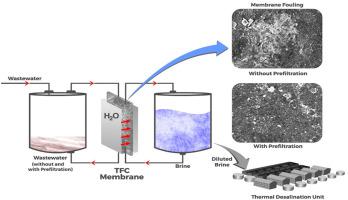Journal of Cleaner Production ( IF 9.7 ) Pub Date : 2021-09-22 , DOI: 10.1016/j.jclepro.2021.129129 Daoud Khanafer 1 , Idris Ibrahim 1 , Sudesh Yadav 1 , Ali Altaee 1 , Alaa Hawari 2 , John Zhou 1

|
The forward osmosis (FO) process was suggested as a pretreatment to a multi-stage flashing (MSF) plant to reduce the environmental impact of brine discharge and the chemicals used. Yet, there is no study investigating the performance of the FO process pretreatment to the MSF plant using tertiary sewage effluent (TSE) as a feed solution. Combining MSF brine with the TSE generates a considerable permeation flux, reducing the membrane area and capital cost. This study evaluated the performance of the FO process for indirect desalination of the MSF brine, considering membrane fouling, cleaning, required membrane area and the specific power consumption. The FO process used a thin-film composite (TFC) membrane to dilute the brine reject from the MSF plant by the TSE and hence converting waste solutions into a feasible water resource. A considerable high water flux (±35 L/m2h) was generated and slightly decreased throughout each experiment's 4 cycles. An enhancement in the water permeability was observed in the FO tests with a prefiltration of the brine reject and the wastewater with 20 μm and an osmotic backwash cleaning of the used membrane. The prefiltration of the draw and feed solutions was effective in minimizing the impact of fouling. Maximum power consumption of 0.007 kWh/m³ was consumed in the forward osmosis process without prefiltration and decreased to 0.006 kWh/m³ in the FO process. The proposed FO system successfully diluted the brine reject’ divalent ions, reducing their concentration to 43% in some cases. Depending on the FO membrane orientation, the TSE feed solution resulted in a 276%–473% reduction in the number of FO elements required in the FO process compared to the seawater feed solution.
中文翻译:

用处理过的废水稀释盐水进行间接脱盐
正向渗透 (FO) 工艺被建议作为多级闪蒸 (MSF) 工厂的预处理,以减少盐水排放和所用化学品对环境的影响。然而,没有研究调查使用三级污水 (TSE) 作为进料溶液对 MSF 工厂进行 FO 工艺预处理的性能。将 MSF 盐水与 TSE 结合会产生相当大的渗透通量,从而减少膜面积和资本成本。本研究评估了 FO 工艺对 MSF 盐水间接脱盐的性能,考虑了膜污染、清洁、所需的膜面积和特定的功耗。FO 工艺使用薄膜复合 (TFC) 膜来稀释 TSE 从 MSF 工厂排出的盐水,从而将废液转化为可行的水资源。2h) 在每个实验的 4 个循环中产生并略有减少。在 FO 测试中观察到水渗透率的提高,其中对盐水截留物和废水进行了 20 μm 的预过滤,并对使用过的膜进行了渗透反洗清洗。抽吸和进料溶液的预过滤可有效减少结垢的影响。无预过滤的正向渗透过程消耗的最大功率消耗为 0.007 kWh/m³,而在 FO 过程中则降至 0.006 kWh/m³。提议的 FO 系统成功地稀释了盐水残留物的二价离子,在某些情况下将其浓度降低到 43%。根据 FO 膜的取向,与海水进料溶液相比,TSE 进料溶液使 FO 工艺所需的 FO 元件数量减少了 276%–473%。











































 京公网安备 11010802027423号
京公网安备 11010802027423号